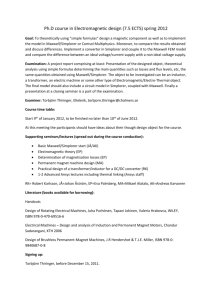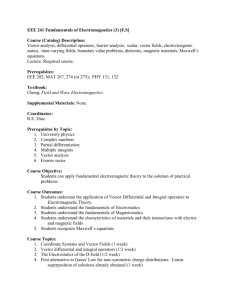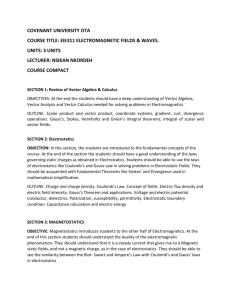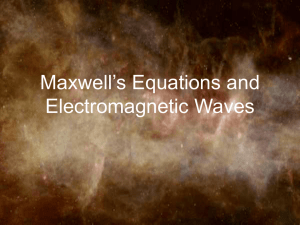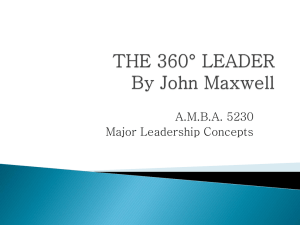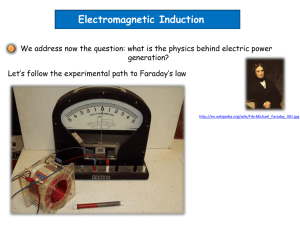Maxwell's Modification in Ampere's Law
advertisement
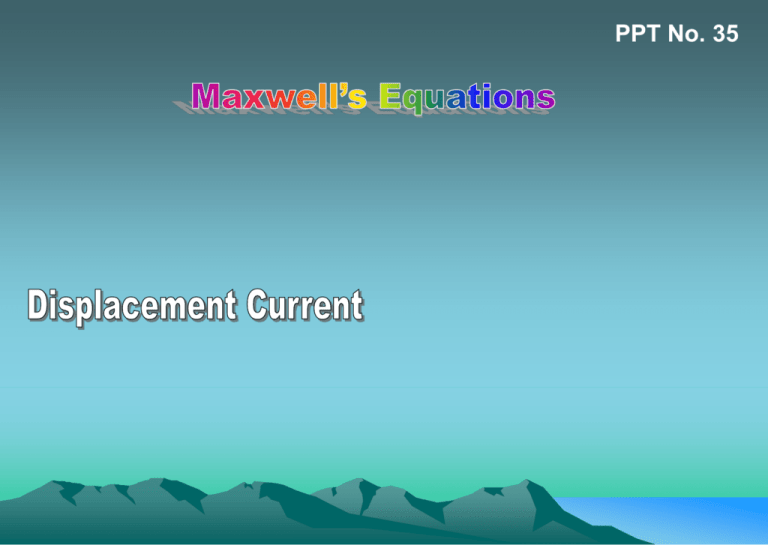
PPT No. 35 Ampere’s Law and the Conservation of Charge Ampere’s original law in differential form states that the curl of Magnetic field equals Current density . Symbolically B is the magnetic field, j is the current densityIt represents the flow of electric charge. Ampere’s Law and the Conservation of Charge Consider the divergence of both sides of the equation. The divergence of the curl of any vector field is identically zero. LHS = 0 LHS = => RHS is zero Ampere’s Law and the Conservation of Charge However, According to the Continuity equation ≠ 0 Thus there is inconsistency between original circuital law (as stated by Ampère) & the law of conservation of charge. Ampère's law seems to be applicable only in limited situations where charge density is constant. Maxwell concluded that this equation was incomplete. He did the needed amendment to the RHS. Maxwell’s Modification in Ampere’s Law According to Coulomb’s law Taking the partial derivative with respect to time and using commutative property of partial differentiation However, According to Continuity equation Combining above two equations => Maxwell’s Modification in Ampere’s Law Since the combination of charge conservation and Coulomb’s law implies that the divergence of (j + ∂E/∂t) is zero, the term on RHS (vector j) in equation 1 should be replaced by the vector j + ∂E/∂t. The extra term in Ampere’s law gives the divergenceless field as required. Maxwell’s Modification in Ampere’s Law In material media, Since But (According to the Continuity equation) Gauss's Law converted to differential form using Divergence theorem is => Maxwell’s Modification in Ampere’s Law The Continuity equation is rewritten as or where D = Displacement vector and Maxwell’s Modification in Ampere’s Law The additional term or ε0∂E/∂t by which Maxwell augmented the equation is called as the displacement current as it involves the rate of change of the dielectric displacement vector D. Maxwell’s Modification in Ampere’s Law The Statement of corrected form of Ampère's circuital law Differential form Integral form The integral of the magnetic field B around a closed circuit path ∂S is equal to the sum of terms due to current density J through any surface spanning the loop and the displacement current ε0 ∂E / ∂t through the surface. Maxwell’s Argument for the Displacement Current Maxwell postulated the concept of displacement current in part III of his paper 'On Physical Lines of Force' (1861). According to Maxwell's concept of the vacuum, the aether, had dielectric properties, and there was motion of charges in the vacuum similar to that in the dielectric material which gave rise to the displacement current. This explanation caused tremendous confusion and misunderstanding among physics community. Maxwell’s Argument for the Displacement Current Presently, his concept of aether is discarded and Maxwell’s explanation is not accepted. Nonetheless, the equation modified by him by adding the term of displacement current is one of the set of four of Maxwell’s equations Explanation using Charging of Capacitor The current density j at a given location does not actually represent the total current flow at that location (even though that is essentially its definition). The process of linear polarization of a dielectric mediumA dielectric medium can be considered to consist of atoms having pairs of positive and negative charges. Explanation using Charging of Capacitor In the presence of electric field E, these charges are pulled in opposite directions, stretching the links between them until they achieve equilibrium. If the strength of the field is increased, the charges are pulled further apart, so during periods when the electric field is changing there is movement of the electric charge elements of the dielectric medium. Explanation using Charging of Capacitor These moving charges contribute to current flow in the direction of the applied electric field. This current must produce magnetic field, and hence should be added to the conduction current. This movement of charge is proportional to ε0∂E/∂t. It is called as the displacement current. This is the mechanism of creation a magnetic field due to a time-varying electric field. Importance of the Displacement Current Maxwell utilized the correction to Ampère's circuital law in his paper (1864) entitled “A Dynamical Theory of the Electromagnetic Field”. The inclusion of the “displacement current” in Ampere’s formula was the key contribution by Maxwell in his electromagnetic field theory Importance of the Displacement Current By adding the term due to the displacement current to the real current, the Ampere’s law becomes complete and self-consistent mathematically and physically. It is one of the four Maxwell’s field equations of electromagnetism. Importance of the Displacement Current The modification of Ampere’s equation by adding the term of Displacement current ε0∂E/∂t leads to the existence of transverse electromagnetic waves propagating in a vacuum at the speed of lightIt is a result of tremendous importance.

